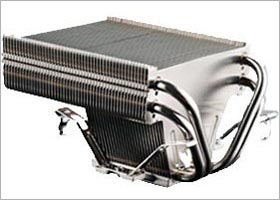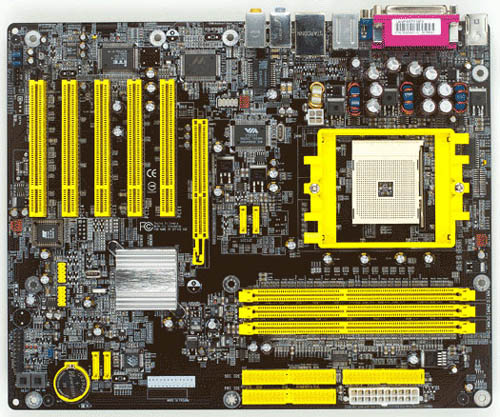Overclocking Buyer's Guide - September 2004
by Wesley Fink on September 17, 2004 12:05 AM EST- Posted in
- Guides
CPU and Motherboard: VALUE OC Recommendations
CPU: AMD Athlon 64 3200+ Retail (2.2Ghz, 512k cache) or AMD Athlon 64 3200+ Mobile (2.0GHz, 1MB Cache)Motherboard: DFI LANParty UT nF3 250Gb
Price: CPU - $213 shipped (Retail). Motherboard - $137 shipped
For the first time, an Athlon 64 socket 754 gets the nod as our Value OC favorite. With most recent Athlon 64 reaching around 2.5GHz or higher, the task was finding an A64 that gave great value and also had a real history of significant overclocking. AMD, like Intel, has different flavors of A64 available at the same clock frequency. It was pretty easy to see that the 3200+ offered great value and great overclocking abilities, but the question was which 3200+. There are now 3 varieties of 3200+ - the original 2.0Ghz with 1MB of cache, the updated 2.2Ghz with 512k of cache, and the new mobile A64 at 2.0Ghz with 1MB of cache.
Since Overclocking goals may be a bit different for different end-users, we chose two 3200+ Athlon 64 CPUs, each of which sells for about $213.

The latest 3200+ is based on the update Newcastle core and runs at 2.2Ghz with 512k cache. We have found the newer 3200+ to be a particularly good overclocker with most users reaching 2.5Ghz with relative ease. Some reach much higher than this OC. We selected the retail version of the 3200+, which comes with the competent AMD HSF made by Ajigo.

If you prefer a little cooler CPU with lower rated wattage consumption, the 3200+ mobile is an excellent choice. While this A64 is rated at the same 1.5V as the desktop 3200+, it is specifies at lower wattage, at stock speed. This translates into lower heat and a likely higher overclock. The Value OC DFI LANParty UT handles the mobile 3200+ with ease, something that cannot be said of many other socket 754 boards.
Please keep in mind that the mobile A64 does not have a heatspreader and therefore, the height is a bit shallower than the stock desktop 3200+. Many HSF do not provide adequate contact with the core of the mobile. A solution that is reported to work fine with the mobile A64 is the Thermalright XP-90.

The XP-90 replaces the Athlon 64 cage with a cage more like the Pentium 4. In fact, the Thermalright will work with either CPU. Since the attachment springs have great range, it is easy to get the kind of core contact required to cool the mobile A64 properly. The XP-90 supports a 92mm fan, so you can select a big, high output fan that moves a lot of air at slower, quieter speeds. If you want a 120mm fan, the more expensive XP-120 supports that option. While the XP-90 fits any board that we have seen, the massive XP-120 is very picky about lots of CPU space for mounting. Take a close look before you move to the 120.
While the 3200+ and mobile 3200+ both cost $213, you will need to add the XP-90 HSF and a 92mm fan to the cost of the mobile 3200+. That adds about $55 to the total. Your reward is that the mobile will likely run cooler at stock and it will also likely overclock even further than a desktop 3200+. You also get a full 1MB of cache instead of 512k, which can be important in games like Doom3.

As we clearly saw in our recent review of the DFI LANParty UT nf3 250Gb, this is a board that is likely to become an overclocking legend. If you plan to overclock a 754, this is the board to choose. No other 754 has come close to the DDR616 1:1 memory performance that we achieved on the DFI. It also has the overclocking features and extended adjustment ranges that will put a smile on any overclocker's face.
The DFI is another Gold Editors choice, and it earned this award with overclocking prowess that stood out from the crowd. No other production 754 offers the overclocking control of the LANParty UT, which is why this board now tops the Orb at Future Mark for 3DMark2001SE. You can do a lot with a late 3200+, and the DFI will take your CPU and memory to levels no other board can reach. It also does it with an ease and stability that you will grow to admire over time.
It took quite a board to push out the legendary Asus P4C800-E as the Value OC champ, but the DFI has what it takes. Please take a close look at our review, DFI LANParty UT nF3-250Gb: Overclocker's Dream, and the recent roundup, Socket 754 Roundup, Part 3: Asus, Soltek & DFI for a clear idea of the true capabilities of the LANParty UT.
Listed below is part of our RealTime pricing engine, which lists the lowest prices available on the Intel CPUs and motherboards from many different reputable vendors:
If you cannot find the lowest prices on the products that we've recommended on this page, it's because we don't list some of them in our RealTime pricing engine. Until we do, we suggest that you do an independent search online at the various vendors' web sites. Just pick and choose where you want to buy your products by looking for a vendor located under the "Vendor" heading.










31 Comments
View All Comments
MemberSince97 - Friday, September 17, 2004 - link
^^GJ^^ WF...Wesley Fink - Friday, September 17, 2004 - link
#10 - I just checked the ORB for 3DMark2001SE and the highest placing Intel was #10 - the 9 top scores were AMD. 2001SE IS sensitive to CPU speed and memory speed and is useful for comparing CPU's.3DMark2003 is not very sensitive to CPU and Memory, so it is excellent for testing pure video performance. Intel does lead in many of the top ten 3DMark2003 scores, but that is a result of Video card performance since 03 is very video centric. Consider the leads there the result of Intel's chipset prowess in graphics support. Looking at the top 20 it is like 50/50 AMD/Intel in 03.
#17 - The DFI is already for sale in the US. The problem is it is selling out very quickly. Additional production is on it's way to resellers, and DFI is gearing up more production for October.
gnumantsc - Friday, September 17, 2004 - link
Just a little typo in regards to 2 x 74GB Western Digital 74GB Raptor 10,000RPM SATA RAID (148MB Total) Should be 148GB not MB.Unless there is a raid system to make your 2 HDs 1000 times smaller :)
helopilot - Friday, September 17, 2004 - link
Wesley: What an *excellent*, well written article! Full of veryuseful info, specs, opinions and lots of general observations and
tips. I think this is one of the best pieces I've read on a
hardware review site. You must have invested considerable time on
this article!
I especially appreciate the level of detail you've incorporated and
the tables, diagrams, graphics etc. that really help to get the
information across to the reader. You deserve high praise indeed
for this level of tech writing.
Keep up the Good Work!
PolaroidPaul - Friday, September 17, 2004 - link
Great review but one issue that bugs me. I am looking into building a value OC system and it sure seems like the DFI board is a good one. Unfortunately, it is practically vapor ware at the present time.Maybe parts that are not readily available should not be on the recommended list. I hate having to wait for parts to show up in distribution while every article tells me how good the sample was. Tell me about what is comming but don't put it on the list if it does not show up as availalbe on your real time pricing list.
Just my humble opinion!
Illissius - Friday, September 17, 2004 - link
I will repeat the stuff about the value RAM. You say yourself that the A64 isn't as sensitive to memory bandwidth, and the doubling of it with socket 939 only results in 2-9% performance gains. 'Enthusiast' memory is a lot less than twice as fast, so you can extrapolate how much extra performance that would gain, and it makes little sense to spend double on it when that money would be much better spent on a faster processor or video card*.Actually, you should just split the memory into Performance and Value, same as with the processor. Ballistix and EB for Performance, and standard value RAM from someone reputable (eg Corsair Value Select) for the Value. Hell, why not seperate /every/ component into Performance and Value? 9800Pro/6600GT and 6800GT for the video card, WD Raptor and random 120-200GB drives, and so on.
...I'm starting to think that the best thing to do would be to just flat out split the Performance and Value into seperate buyer's guides. They're at least as different as the mid- and high end guides are.
One more thing, and then I'll stop - the HSF has much more significance in the overclocking equation than you seem to be attributing it. You don't need to give it a seperate section, just mentioning a list of the better choices would be nice (afaik, Zalman CNPS7000A-(Al)Cu, Thermalright SLK-947/8U, SP-94/7/8, and XP-90/120, and possibly others), because for the person just getting into the whole overclocking thing, they may not know ;).
* Contrary to a common misconception, you don't need faster memory to overclock the processor. Most boards can lock the memory at stock speeds, or otherwise can use a 5:4 ratio or something.
iversonyin - Friday, September 17, 2004 - link
i would fork out a little more for 2800+ athlon 64 then usin the sempronhes right on the money $20 more, u r better off with 2800+ 64 then sempron
thebluesgnr - Friday, September 17, 2004 - link
#13,it's actually:
X300SE = 9600SE
X300 = 9600
X600PRO = 9600PRO
X600XT = 9600XT
No 9200 in PCIe.
DEMO24 - Friday, September 17, 2004 - link
This is to poster #2. You CAN buy a x300 or x600. its called the 9200 for a x300 and a 9600 for the x600. Theres nothing speical to the x cards below the x800 cuase they are all jsut old cards made to fit PCI-e. A good way for ATI to make money and look good.ksherman - Friday, September 17, 2004 - link
Yippie! someone finally OCed a Sempron! Ive been wondering how well those cheapos would do... Sounds amazing!